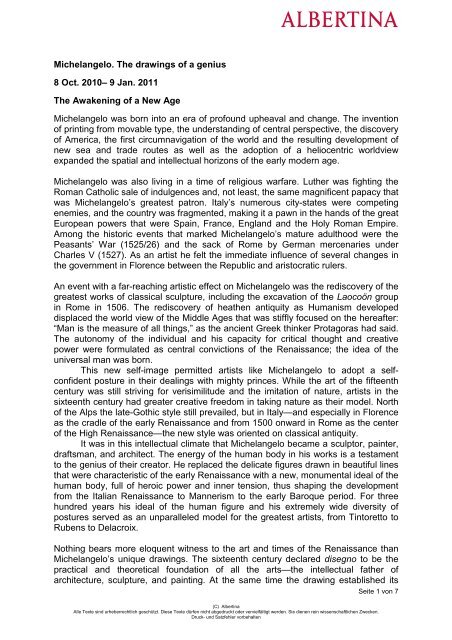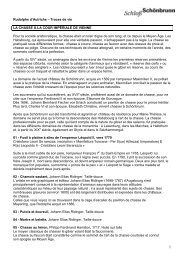Michelangelo. The drawings of a genius - Freizeitbetriebe-wien.at
Michelangelo. The drawings of a genius - Freizeitbetriebe-wien.at
Michelangelo. The drawings of a genius - Freizeitbetriebe-wien.at
Create successful ePaper yourself
Turn your PDF publications into a flip-book with our unique Google optimized e-Paper software.
<strong>Michelangelo</strong>. <strong>The</strong> <strong>drawings</strong> <strong>of</strong> a <strong>genius</strong><br />
8 Oct. 2010– 9 Jan. 2011<br />
<strong>The</strong> Awakening <strong>of</strong> a New Age<br />
<strong>Michelangelo</strong> was born into an era <strong>of</strong> pr<strong>of</strong>ound upheaval and change. <strong>The</strong> invention<br />
<strong>of</strong> printing from movable type, the understanding <strong>of</strong> central perspective, the discovery<br />
<strong>of</strong> America, the first circumnavig<strong>at</strong>ion <strong>of</strong> the world and the resulting development <strong>of</strong><br />
new sea and trade routes as well as the adoption <strong>of</strong> a heliocentric worldview<br />
expanded the sp<strong>at</strong>ial and intellectual horizons <strong>of</strong> the early modern age.<br />
<strong>Michelangelo</strong> was also living in a time <strong>of</strong> religious warfare. Luther was fighting the<br />
Roman C<strong>at</strong>holic sale <strong>of</strong> indulgences and, not least, the same magnificent papacy th<strong>at</strong><br />
was <strong>Michelangelo</strong>’s gre<strong>at</strong>est p<strong>at</strong>ron. Italy’s numerous city-st<strong>at</strong>es were competing<br />
enemies, and the country was fragmented, making it a pawn in the hands <strong>of</strong> the gre<strong>at</strong><br />
European powers th<strong>at</strong> were Spain, France, England and the Holy Roman Empire.<br />
Among the historic events th<strong>at</strong> marked <strong>Michelangelo</strong>’s m<strong>at</strong>ure adulthood were the<br />
Peasants’ War (1525/26) and the sack <strong>of</strong> Rome by German mercenaries under<br />
Charles V (1527). As an artist he felt the immedi<strong>at</strong>e influence <strong>of</strong> several changes in<br />
the government in Florence between the Republic and aristocr<strong>at</strong>ic rulers.<br />
An event with a far-reaching artistic effect on <strong>Michelangelo</strong> was the rediscovery <strong>of</strong> the<br />
gre<strong>at</strong>est works <strong>of</strong> classical sculpture, including the excav<strong>at</strong>ion <strong>of</strong> the Laocoön group<br />
in Rome in 1506. <strong>The</strong> rediscovery <strong>of</strong> he<strong>at</strong>hen antiquity as Humanism developed<br />
displaced the world view <strong>of</strong> the Middle Ages th<strong>at</strong> was stiffly focused on the hereafter:<br />
“Man is the measure <strong>of</strong> all things,” as the ancient Greek thinker Protagoras had said.<br />
<strong>The</strong> autonomy <strong>of</strong> the individual and his capacity for critical thought and cre<strong>at</strong>ive<br />
power were formul<strong>at</strong>ed as central convictions <strong>of</strong> the Renaissance; the idea <strong>of</strong> the<br />
universal man was born.<br />
This new self-image permitted artists like <strong>Michelangelo</strong> to adopt a selfconfident<br />
posture in their dealings with mighty princes. While the art <strong>of</strong> the fifteenth<br />
century was still striving for verisimilitude and the imit<strong>at</strong>ion <strong>of</strong> n<strong>at</strong>ure, artists in the<br />
sixteenth century had gre<strong>at</strong>er cre<strong>at</strong>ive freedom in taking n<strong>at</strong>ure as their model. North<br />
<strong>of</strong> the Alps the l<strong>at</strong>e-Gothic style still prevailed, but in Italy—and especially in Florence<br />
as the cradle <strong>of</strong> the early Renaissance and from 1500 onward in Rome as the center<br />
<strong>of</strong> the High Renaissance—the new style was oriented on classical antiquity.<br />
It was in this intellectual clim<strong>at</strong>e th<strong>at</strong> <strong>Michelangelo</strong> became a sculptor, painter,<br />
draftsman, and architect. <strong>The</strong> energy <strong>of</strong> the human body in his works is a testament<br />
to the <strong>genius</strong> <strong>of</strong> their cre<strong>at</strong>or. He replaced the delic<strong>at</strong>e figures drawn in beautiful lines<br />
th<strong>at</strong> were characteristic <strong>of</strong> the early Renaissance with a new, monumental ideal <strong>of</strong> the<br />
human body, full <strong>of</strong> heroic power and inner tension, thus shaping the development<br />
from the Italian Renaissance to Mannerism to the early Baroque period. For three<br />
hundred years his ideal <strong>of</strong> the human figure and his extremely wide diversity <strong>of</strong><br />
postures served as an unparalleled model for the gre<strong>at</strong>est artists, from Tintoretto to<br />
Rubens to Delacroix.<br />
Nothing bears more eloquent witness to the art and times <strong>of</strong> the Renaissance than<br />
<strong>Michelangelo</strong>’s unique <strong>drawings</strong>. <strong>The</strong> sixteenth century declared disegno to be the<br />
practical and theoretical found<strong>at</strong>ion <strong>of</strong> all the arts—the intellectual f<strong>at</strong>her <strong>of</strong><br />
architecture, sculpture, and painting. At the same time the drawing established its<br />
Seite 1 von 7<br />
(C) Albertina<br />
Alle Texte sind urheberrechtlich geschützt. Diese Texte dürfen nicht abgedruckt oder vervielfältigt werden. Sie dienen rein wissenschaftlichen Zwecken.<br />
Druck- und S<strong>at</strong>zfehler vorbehalten
st<strong>at</strong>us as an independent artwork th<strong>at</strong> expressed the cre<strong>at</strong>ive idea and the<br />
temperament <strong>of</strong> the artist. <strong>Michelangelo</strong>’s contemporaries guarded his <strong>drawings</strong> like<br />
jewels, as they reflected the wide range and variety <strong>of</strong> ideas by this ingenious artist.<br />
<strong>Michelangelo</strong> in Florence<br />
Early Drawings<br />
In their accounts <strong>of</strong> the artist’s life, Ascanio Condivi and Giorgio Vasari report th<strong>at</strong><br />
<strong>Michelangelo</strong> showed a keen interest in drawing even as a boy. When his f<strong>at</strong>her sent<br />
the thirteen-year-old for an apprenticeship under the important Florentine painter<br />
Domenico Ghirlandaio, the l<strong>at</strong>ter was immedi<strong>at</strong>ely astounded by his pupil’s<br />
exceptional talent. According to Vasari, <strong>Michelangelo</strong> once revised a drawing by<br />
Ghirlandaio, to the astonishment <strong>of</strong> everyone, by retracing the lines with stronger ink<br />
to demonstr<strong>at</strong>e how they were supposed to run. <strong>The</strong> artist’s early pen-and-ink<br />
<strong>drawings</strong> are unmistakably in keeping with Ghirlandaio’s technique, which forms a<br />
rhythmical, decor<strong>at</strong>ive network <strong>of</strong> lines on the surface. <strong>Michelangelo</strong>’s lines, on the<br />
other hand, are more regular and controlled, consisting <strong>of</strong> straight lines th<strong>at</strong> cre<strong>at</strong>e<br />
parallel levels and in many places are concentr<strong>at</strong>ed to produce dense cross-h<strong>at</strong>ching.<br />
<strong>The</strong> position and function <strong>of</strong> each detail is clearly defined and sculpturally<br />
transl<strong>at</strong>able. In the beginning, the artist liked to combine two different colors <strong>of</strong> ink,<br />
thus loosening the line-work and lending the composition a more colorful impression.<br />
It was a common practice in the workshop training <strong>of</strong> apprentices for pupils to copy<br />
the works <strong>of</strong> gre<strong>at</strong> artists. <strong>Michelangelo</strong> is said to have copied various sheets by older<br />
masters in a faithful manner, before coloring, smearing, and smoking them to make<br />
them appear old. Among the earliest <strong>drawings</strong> <strong>of</strong> his youth are the three famous<br />
copies based on frescoes by Giotto and Masaccio, whom <strong>Michelangelo</strong> admired for<br />
their simplicity and coherent figural language. Following their example, he developed<br />
a new ideal <strong>of</strong> depicting the human figure, characterized by dignified gre<strong>at</strong>ness,<br />
heroic grandeur, and monumentality.<br />
<strong>The</strong> B<strong>at</strong>tle <strong>of</strong> Cascina<br />
Since the twelfth century, Italy had been structured in independent city-st<strong>at</strong>es, which<br />
were struggling to maintain their position vis-à-vis one another and against the<br />
pretensions to power <strong>of</strong> the Papal St<strong>at</strong>es. Seven years after the fall <strong>of</strong> the Medici and<br />
the establishment <strong>of</strong> the Republic <strong>of</strong> Florence, the government commissioned a<br />
decor<strong>at</strong>ive program for its se<strong>at</strong> in the Palazzo della Signoria (Palazzo Vecchio).<br />
Florentine pride was to be celebr<strong>at</strong>ed in pictures documenting the gre<strong>at</strong>est military<br />
victories in the city’s history. In a kind <strong>of</strong> artistic contest, the young <strong>Michelangelo</strong> in<br />
1504 faced the experienced artist Leonardo da Vinci, who in 1503 had started to<br />
paint <strong>The</strong> B<strong>at</strong>tle <strong>of</strong> Anghiari (1440) against Milan, while <strong>Michelangelo</strong> depicted the<br />
dram<strong>at</strong>ic events <strong>of</strong> July 28, 1364, in <strong>The</strong> B<strong>at</strong>tle <strong>of</strong> Cascina.<br />
Since 1362 Florence had been in a trade war with Pisa, which had sometimes gained<br />
the upper hand. <strong>Michelangelo</strong> followed the account <strong>of</strong> Filippo Villani, according to<br />
which the Florentine troops were b<strong>at</strong>hing in the Arno River to escape the extreme<br />
summer he<strong>at</strong>. <strong>The</strong>y were discovered by their enemies who caught them in a surprise<br />
<strong>at</strong>tack, but thanks to their commander’s perspicacity they won the day.<br />
Seite 2 von 7<br />
(C) Albertina<br />
Alle Texte sind urheberrechtlich geschützt. Diese Texte dürfen nicht abgedruckt oder vervielfältigt werden. Sie dienen rein wissenschaftlichen Zwecken.<br />
Druck- und S<strong>at</strong>zfehler vorbehalten
<strong>Michelangelo</strong> chose the moment between the surprise and the reaction <strong>of</strong> the<br />
soldiers, who rushed to arms. While Leonardo staged the dynamic clash <strong>of</strong> riders and<br />
soldiers in all its brutality and violence, <strong>Michelangelo</strong> structured his composition on<br />
three sp<strong>at</strong>ial levels and conceived the event as an “allegory <strong>of</strong> vigilance.” His<br />
contemporaries were immedi<strong>at</strong>ely fascin<strong>at</strong>ed by his draft because <strong>of</strong> the expressive,<br />
richly varied postures and complex rot<strong>at</strong>ional movements <strong>of</strong> the bodies. <strong>The</strong> threedimensional<br />
definition <strong>of</strong> the figures and the effort to make them spaceencompassing<br />
was yet another achievement th<strong>at</strong> had a lasting effect on subsequent<br />
gener<strong>at</strong>ions <strong>of</strong> artists. Neither Leonardo nor <strong>Michelangelo</strong> completed their drafts,<br />
which are known only partially and in copies.<br />
<strong>Michelangelo</strong> in Rome<br />
Sistine Chapel<br />
With the ascendance to the papacy <strong>of</strong> Julius II (1503), <strong>Michelangelo</strong> had secured his<br />
most important p<strong>at</strong>ron. Part <strong>of</strong> the new pope’s politics <strong>of</strong> power was to strengthen the<br />
Papal St<strong>at</strong>es and make them a Renaissance cultural stronghold, and to th<strong>at</strong> end he<br />
employed Bramante and Raphael. In 1505 he summoned <strong>Michelangelo</strong> to Rome to<br />
build his papal tomb. As the construction <strong>of</strong> the new Saint Peter’s became an<br />
important priority for the pope, however, he asked the artist to paint the ceiling <strong>of</strong> the<br />
Sistine Chapel. Disappointed <strong>at</strong> having to break <strong>of</strong>f the tomb project, <strong>Michelangelo</strong>,<br />
who saw himself primarily as a sculptor, was initially reluctant to accept the new<br />
commission.<br />
According to <strong>Michelangelo</strong> himself, he independently developed his complex program<br />
<strong>of</strong> scenes from the story <strong>of</strong> the Cre<strong>at</strong>ion and the lives <strong>of</strong> the p<strong>at</strong>riarchs Moses and<br />
Noah accompanied by the biblical prophets and the ancestors <strong>of</strong> Christ combined<br />
with figures from he<strong>at</strong>hen mythology. It is likely, however, th<strong>at</strong> he received advice<br />
from theologians <strong>at</strong> the papal court.<br />
<strong>The</strong> paintings were executed in keeping with a horizontal illusionistic architectural<br />
system <strong>of</strong> arrangement, beginning with the central field <strong>of</strong> vaulting above the two<br />
adjoining fields with prophets and sibyls and continuing with the lunettes and the<br />
curved undersurfaces above them. With more than 300 figures charged with energy<br />
and characterized by highly expressive gestures and individual expressions, the artist<br />
cre<strong>at</strong>ed a universe <strong>of</strong> human emotions, <strong>at</strong> the same time bringing to life with dram<strong>at</strong>ic<br />
intensity the theme <strong>of</strong> an almighty God and the consequences <strong>of</strong> the divine plan <strong>of</strong><br />
salv<strong>at</strong>ion for humankind.<br />
While <strong>Michelangelo</strong> is unique and highly vers<strong>at</strong>ile as an artist, <strong>at</strong> the same time his<br />
program is also typical <strong>of</strong> the thinking <strong>of</strong> his time. Inspired by Neopl<strong>at</strong>onism, his<br />
striving for perfection in cre<strong>at</strong>ing an ideal human image is manifested in the content<br />
as well as in the stylistic execution.<br />
<strong>The</strong> Tomb <strong>of</strong> Julius II<br />
Pope Julius II was born as Giuliano della Rovere into a poor but respected<br />
aristocr<strong>at</strong>ic family. He is known as a power-loving, warrior pope and important p<strong>at</strong>ron<br />
<strong>of</strong> the arts. It was not unusual in his day for the goals <strong>of</strong> the head <strong>of</strong> the church to<br />
coincide with family territorial and societal ambitions and for personal interests to<br />
coincide with those <strong>of</strong> the st<strong>at</strong>e. Despite the high cost <strong>of</strong> his campaigns to retake<br />
Venice and protect the Papal St<strong>at</strong>es from the major European powers, Julius II was a<br />
Seite 3 von 7<br />
(C) Albertina<br />
Alle Texte sind urheberrechtlich geschützt. Diese Texte dürfen nicht abgedruckt oder vervielfältigt werden. Sie dienen rein wissenschaftlichen Zwecken.<br />
Druck- und S<strong>at</strong>zfehler vorbehalten
typical Renaissance ruler and thus a generous supporter <strong>of</strong> the arts. With<br />
<strong>Michelangelo</strong>’s ceiling frescoes for the Sistine Chapel, the new Saint Peter’s,<br />
Bramante’s remodeling <strong>of</strong> the V<strong>at</strong>ican palace, and Raphael’s cycle <strong>of</strong> frescoes for the<br />
V<strong>at</strong>ican apartments, Julius II commissioned extremely important artistic projects.<br />
In 1505 he gave <strong>Michelangelo</strong> his first promising commission: to cre<strong>at</strong>e a<br />
monumental personal tomb in the old Saint Peter’s. It was to surpass every existing<br />
tomb in size, magnificence and richness <strong>of</strong> sculptural decor<strong>at</strong>ion, with more than 40<br />
figures to glorify the pontiff’s political and cultural achievements. <strong>The</strong> project was to<br />
be recorded in <strong>Michelangelo</strong>’s artistic biography as the “tragedy <strong>of</strong> his life.” <strong>The</strong><br />
execution <strong>of</strong> the original plan was prevented by other papal commissions, and<br />
following the de<strong>at</strong>h <strong>of</strong> Julius II in February 1513, his heirs altered the design, rejecting<br />
the free-standing, walk-in mausoleum in favor <strong>of</strong> a still-impressive but significantly<br />
smaller wall tomb.<br />
By the time it was finally erected in San Pietro in Vincoli (1532-45), r<strong>at</strong>her than in<br />
Saint Peter’s, six more contracts entailing changes had been negoti<strong>at</strong>ed. While the<br />
first draft provided for a program <strong>of</strong> classical sculpture, Christian motifs were<br />
predominant in the l<strong>at</strong>er designs. Nothing remains <strong>of</strong> <strong>Michelangelo</strong>’s original idea but<br />
the descriptions <strong>of</strong> Vasari and Condivi. No l<strong>at</strong>er use was made <strong>of</strong> the famous<br />
sculptures <strong>of</strong> the Slaves in Paris and Florence.<br />
<strong>Michelangelo</strong> and Sebastiano del Piombo<br />
<strong>The</strong> Venetian painter Sebastiano Luciani (1485-1547, l<strong>at</strong>er known as Sebastiano del<br />
Piombo) came to Rome in 1511 under the p<strong>at</strong>ronage <strong>of</strong> the wealthy Sienese banker<br />
Agostino Chigi. <strong>The</strong>re he soon became friends with <strong>Michelangelo</strong>, who took him<br />
under his wing. In Rome Raphael’s painting was considered superior to th<strong>at</strong> <strong>of</strong><br />
<strong>Michelangelo</strong>; thus the l<strong>at</strong>ter joined forces with Sebastiano to compete against<br />
Raphael’s position <strong>of</strong> supremacy. <strong>Michelangelo</strong> admired Sebastiano’s color<strong>at</strong>ion and<br />
made drafts for the paintings <strong>of</strong> his friend, who could not compete with the master<br />
with regard to heroic figural and compositional concepts. <strong>The</strong>ir collabor<strong>at</strong>ion resulted<br />
in a fascin<strong>at</strong>ing combin<strong>at</strong>ion <strong>of</strong> <strong>Michelangelo</strong>’s disegno and sculptural, typically<br />
Florentine figural definition with Sebastiano’s painterly, characteristically Venetian<br />
color<strong>at</strong>ion. Even after his return to Florence, <strong>Michelangelo</strong> continued to send his<br />
friend drafts for paintings.<br />
<strong>The</strong> preliminary <strong>drawings</strong> presented in this exhibition are all from the second decade<br />
<strong>of</strong> the sixteenth century, during which Sebastiano secured <strong>Michelangelo</strong>’s help for<br />
almost every painting. In the mid-fifteen-thirties a controversy broke out between the<br />
two artists because <strong>of</strong> their conflicting opinions regarding the painting technique <strong>of</strong><br />
<strong>The</strong> Last Judgment in the Sistine Chapel, leading to a break in their friendship.<br />
<strong>The</strong> Medici Family Tombs<br />
<strong>The</strong> Medici Chapel<br />
As a sculptor, architect and painter with many years in the service <strong>of</strong> the Medici,<br />
<strong>Michelangelo</strong> was simultaneously occupied with numerous projects in Rome and<br />
Florence. With the ascension to the papacy <strong>of</strong> Leo X in 1513, the influential family<br />
was now in charge <strong>of</strong> the V<strong>at</strong>ican as well. In 1519 <strong>Michelangelo</strong> received his largest<br />
commission to d<strong>at</strong>e: to design the Medici Chapel in San Lorenzo in Florence along<br />
with its sculptural program. Cardinal Giulio de’ Medici and Pope Leo X commissioned<br />
Seite 4 von 7<br />
(C) Albertina<br />
Alle Texte sind urheberrechtlich geschützt. Diese Texte dürfen nicht abgedruckt oder vervielfältigt werden. Sie dienen rein wissenschaftlichen Zwecken.<br />
Druck- und S<strong>at</strong>zfehler vorbehalten
this large project for constructing tombs for the most important members <strong>of</strong> the<br />
Medici family: Lorenzo il Magnifico († 1492), who was <strong>Michelangelo</strong>’s first p<strong>at</strong>ron and<br />
the f<strong>at</strong>her <strong>of</strong> Leo X, and Lorenzo’s brother, Giuliano († 1478), as well as the dukes <strong>of</strong><br />
Nemours († 1516) and Urbino († 1519), Lorenzo’s son and grandson, respectively.<br />
<strong>Michelangelo</strong> based his architectural structure on Brunelleschi’s Old Sacristy th<strong>at</strong><br />
was added as a counterpart to the Medici Chapel. He set new standards, however,<br />
with his completely new formal language. <strong>The</strong> three-dimensional architectural<br />
elements combine with the sculpture in harmonious unity. <strong>The</strong> allegories <strong>of</strong> Day and<br />
Night, Morning and Evening on the ducal tombs are a highlight <strong>of</strong> the sculptural<br />
program, symbolizing the limited time <strong>of</strong> life on earth and the transitoriness <strong>of</strong> the<br />
mortal body. <strong>The</strong> artist studied individual parts <strong>of</strong> the figures in several careful<br />
<strong>drawings</strong> in order to arrive finally <strong>at</strong> the uniquely sensual gestures and introverted<br />
spiritual expressiveness <strong>of</strong> his times <strong>of</strong> the day. <strong>Michelangelo</strong>’s final move to Rome in<br />
1534 as well as the de<strong>at</strong>h <strong>of</strong> the Medici pope <strong>at</strong> the time, Clemens VII, prevented him<br />
from ever completing this huge Gesamtkunstwerk.<br />
Leda and the Swan<br />
During <strong>Michelangelo</strong>’s stay in Ferrara in 1529, Duke Alfonso I d´Este presented his<br />
famous art collection to him and expressed his wish to receive a painting by the<br />
master. Upon this request, <strong>Michelangelo</strong> cre<strong>at</strong>ed a tempera painting <strong>of</strong> Leda and the<br />
Swan within a year. According to the Greek myth, Zeus admired Leda, the wife <strong>of</strong><br />
King Tyndareus <strong>of</strong> Sparta, and seduced her in the guise <strong>of</strong> a swan, their encounter<br />
resulting in the birth <strong>of</strong> the twins Castor and Pollux as well as Helen and<br />
Clytemnestra. <strong>The</strong> duke sent an envoy to Florence, who, according to Vasari, made<br />
disparaging remarks about the painting. Enraged by this tactlessness, <strong>Michelangelo</strong><br />
gave the painting as a gift to his pupil Antonio Mini, who took it with him on his<br />
journey to France in 1531, along with two boxes filled with <strong>drawings</strong> and cartoons by<br />
the master, in order to sell it to King Francis I. Mini, however, did not succeed in<br />
reaching Francis I. L<strong>at</strong>er the painting <strong>of</strong> Leda made its way to Fontainebleau and was<br />
burned there a hundred years l<strong>at</strong>er because <strong>of</strong> its lascivious subject m<strong>at</strong>ter. It is<br />
<strong>Michelangelo</strong>’s most erotic painting and was inspired either by a Roman sarcophagus<br />
relief or an antique cameo. By comparison with those classical models, the artist<br />
enhanced the sensuous aspect <strong>of</strong> the subject by having Leda willingly yield to the<br />
swan’s lascivious urging. <strong>The</strong> engraving by Cornelis Bos shows th<strong>at</strong> the original<br />
fe<strong>at</strong>ured, in addition to the main group, a depiction <strong>of</strong> the two Dioscuri, Castor and<br />
Pollux, as well as Helen as an embryo in an egg.<br />
<strong>The</strong> painted copies in London’s N<strong>at</strong>ional Gallery and by Peter Paul Rubens are not<br />
based on the painting but on <strong>Michelangelo</strong>’s cartoon, which Mini also took with him to<br />
France. On the now lost cartoon, the <strong>of</strong>fspring <strong>of</strong> Jupiter and Leda are not depicted.<br />
<strong>The</strong> preliminary drawing in the Casa Buonarroti for the head <strong>of</strong> Leda is one <strong>of</strong><br />
<strong>Michelangelo</strong>’s most beautiful head studies, executed in red chalk with the finest<br />
articul<strong>at</strong>ion. <strong>The</strong> same kind <strong>of</strong> style is revealed in the picturesquely detailed sheets<br />
Samson and Delilah, Three Labors <strong>of</strong> Hercules, and Archers Shooting <strong>at</strong> a Herm,<br />
which further convey a picture to us <strong>of</strong> the artist’s style <strong>of</strong> drawing around 1530.<br />
Present<strong>at</strong>ion Drawings for Tommaso de’ Cavalieri<br />
Seite 5 von 7<br />
(C) Albertina<br />
Alle Texte sind urheberrechtlich geschützt. Diese Texte dürfen nicht abgedruckt oder vervielfältigt werden. Sie dienen rein wissenschaftlichen Zwecken.<br />
Druck- und S<strong>at</strong>zfehler vorbehalten
At age 57 <strong>Michelangelo</strong> met the 17-year-old Roman nobleman Tommaso de’<br />
Cavalieri. He was immedi<strong>at</strong>ely smitten by the youth’s beauty, distinguished<br />
appearance, and intellect, and the meeting was the beginning <strong>of</strong> a lifelong friendship.<br />
<strong>Michelangelo</strong> sent Tommaso, whom he called “a leading light <strong>of</strong> the century,”<br />
sonnets, letters, and <strong>drawings</strong> in which he expressed his love. He promoted the<br />
young man’s artistic interest and taught him how to draw. Tommaso acquired an<br />
outstanding collection <strong>of</strong> classical artworks and <strong>drawings</strong> and was l<strong>at</strong>er regarded as<br />
an excellent art expert. He supervised building projects <strong>of</strong> the Capitoline magistr<strong>at</strong>e<br />
and supported <strong>Michelangelo</strong>’s l<strong>at</strong>e artistic ventures, such as his wooden modello <strong>of</strong><br />
the dome <strong>of</strong> Saint Peter’s. <strong>The</strong> <strong>drawings</strong> th<strong>at</strong> <strong>Michelangelo</strong> presented to Tommaso as<br />
gifts—<strong>The</strong> Punishment <strong>of</strong> Tityus, <strong>The</strong> Rape <strong>of</strong> Ganymede, <strong>The</strong> Fall <strong>of</strong> Phaeton, and<br />
A Children’s Bacchanal—are executed in an extremely subtle, detailed, and<br />
accomplished manner, depicting classical, mythological subjects. <strong>The</strong> master also<br />
cre<strong>at</strong>ed <strong>drawings</strong> <strong>of</strong> “divine heads” (teste divine) for him, including th<strong>at</strong> <strong>of</strong> Cleop<strong>at</strong>ra,<br />
presented here. On New Year’s Day in 1533, Tommaso expressed his gr<strong>at</strong>itude to<br />
<strong>Michelangelo</strong> for two <strong>drawings</strong>, probably those <strong>of</strong> Tityus and Ganymede, which were<br />
apparently conceived as counterparts.<br />
<strong>The</strong>se present<strong>at</strong>ion <strong>drawings</strong> have been considered pr<strong>of</strong>essions <strong>of</strong> <strong>Michelangelo</strong>’s<br />
love for Tommaso. <strong>The</strong> one <strong>of</strong> Tityus, who is fettered to a rock in Hades because <strong>of</strong><br />
his love for L<strong>at</strong>ona and exposed to the <strong>at</strong>tacks <strong>of</strong> a vulture, brings to mind a sonnet<br />
dedic<strong>at</strong>ed to Tommaso, in which the artist said he was incapable <strong>of</strong> being happy<br />
unless tormented by lovesickness. And Ganymede, the favorite <strong>of</strong> the f<strong>at</strong>her <strong>of</strong> the<br />
gods, is by no means abducted against his will by the eagle; thus this drawing has<br />
been interpreted as an expression <strong>of</strong> the pl<strong>at</strong>onic, all-pervasive passion (E. Pan<strong>of</strong>sky)<br />
th<strong>at</strong> seized <strong>Michelangelo</strong> after he met Tommaso.<br />
<strong>The</strong> Last Judgment<br />
Following the peaceful pontific<strong>at</strong>es <strong>of</strong> the Medici Pope Leo X (1513–1521) and the<br />
Utrecht-born Adrian VI (1522/23), another member <strong>of</strong> the Medici dynasty entered the<br />
V<strong>at</strong>ican as Pope Clement VII. His papacy was marked by the sack <strong>of</strong> Rome (1527)<br />
when the Medici were exiled from Florence, military defe<strong>at</strong>, and the advance <strong>of</strong> the<br />
Protestants. Nevertheless he was a generous p<strong>at</strong>ron <strong>of</strong> the arts, and <strong>Michelangelo</strong>’s<br />
fresco <strong>The</strong> Last Judgment for the altar wall <strong>of</strong> the Sistine Chapel is the most<br />
important work commissioned during his papacy.<br />
As he had done earlier with his ceiling frescoes, <strong>Michelangelo</strong> designed a dram<strong>at</strong>ic<br />
depiction <strong>of</strong> human f<strong>at</strong>e, interpreting the Last Judgment as a monumental apocalyptic<br />
vision <strong>of</strong> the thought <strong>of</strong> redemption and the terror <strong>of</strong> damn<strong>at</strong>ion. Demons are<br />
struggling for the souls <strong>of</strong> the damned, and the dead are awakened with blaring<br />
trumpets, while the redeemed g<strong>at</strong>her around the figure <strong>of</strong> Christ, the mighty Judge <strong>of</strong><br />
the World. Here again, <strong>Michelangelo</strong> combines the biblical narr<strong>at</strong>ive with scenes from<br />
ancient mythology. <strong>The</strong> connection with the Inferno from Dante’s Divine Comedy can<br />
be seen <strong>at</strong> the bottom <strong>of</strong> the fresco in the figure <strong>of</strong> Charon, the ferryman carrying the<br />
dead to the underworld. In the dynamic postures and foreshortening <strong>of</strong> the figures<br />
reaching in all directions as well as in their sculptural quality and moving, powerful<br />
expressiveness we experience the master’s visionary imagin<strong>at</strong>ion in all its cre<strong>at</strong>ive<br />
diversity.<br />
During this period <strong>of</strong> crisis in the church and the resulting efforts to reform it,<br />
<strong>Michelangelo</strong> made the acquaintance <strong>of</strong> the Roman poetess Vittoria Colonna, under<br />
Seite 6 von 7<br />
(C) Albertina<br />
Alle Texte sind urheberrechtlich geschützt. Diese Texte dürfen nicht abgedruckt oder vervielfältigt werden. Sie dienen rein wissenschaftlichen Zwecken.<br />
Druck- und S<strong>at</strong>zfehler vorbehalten
whose influence he entered a phase <strong>of</strong> deep spirituality and religiosity in his artistry.<br />
In this spirit and as a reflection on his own mortality, <strong>Michelangelo</strong> cre<strong>at</strong>ed his l<strong>at</strong>e<br />
Crucifixion and Pietà scenes.<br />
Projects for Fellow Artists<br />
After the completion <strong>of</strong> the frescoes in the Cappella Paolina (1550), <strong>Michelangelo</strong><br />
abandoned painting. From th<strong>at</strong> time on he devoted himself to sculpture and focused<br />
intensively on gre<strong>at</strong> architectural projects, such as building the new Saint Peter’s<br />
Basilica. He continued, however, to cre<strong>at</strong>e drafts for paintings by fellow artists such<br />
as Marcello Venusti and Daniele da Volterra, who in their works preserved his<br />
inventions for posterity. While he provided a compositionally accomplished<br />
preliminary drawing (a so-called cartonetto) for Marcello Venusti’s painting <strong>of</strong> the<br />
Annunci<strong>at</strong>ion, he gave Daniele smaller drafts. <strong>The</strong> master’s four New York sketches<br />
are initial ideas for Daniele’s picture <strong>of</strong> David and Goli<strong>at</strong>h in the Louvre, showing the<br />
group from the front and the back, respectively. Daniele is said to have used a clay<br />
model for the depictions from two sides, yet r<strong>at</strong>her than rendering the postures<br />
identically, he altered them, thus illustr<strong>at</strong>ing th<strong>at</strong> painting, as compared to sculpture,<br />
has the opportunity <strong>of</strong> vari<strong>at</strong>ions. <strong>The</strong> painting is an exceptional contribution to the<br />
paragone, the lively deb<strong>at</strong>e in the Renaissance about which art genre was superior:<br />
painting or sculpture. Daniele did not adopt the master’s drafts mechanically; r<strong>at</strong>her<br />
he independently developed them further or elabor<strong>at</strong>ed them in detailed individual<br />
studies.<br />
L<strong>at</strong>e Crucifixion Drawings<br />
<strong>The</strong> three poignant depictions <strong>of</strong> the Crucifixion <strong>of</strong> Christ belong to a series <strong>of</strong><br />
stylistically rel<strong>at</strong>ed <strong>drawings</strong> on the subject. <strong>The</strong>y are frequently <strong>at</strong>tributed to the<br />
artist’s last cre<strong>at</strong>ive period, although the exact d<strong>at</strong>e <strong>of</strong> their cre<strong>at</strong>ion cannot be<br />
established with certainty. In these <strong>drawings</strong> <strong>Michelangelo</strong> focuses on the essential,<br />
omits decor<strong>at</strong>ive details, and reduces the figures to simple, block-like forms. Standing<br />
bene<strong>at</strong>h the Cross are Saint John and the Mother <strong>of</strong> God. <strong>The</strong>y are left entirely to<br />
their own devices in an empty space th<strong>at</strong> dram<strong>at</strong>ically reveals the hopelessness <strong>of</strong><br />
their situ<strong>at</strong>ion. <strong>The</strong>y are either plainly venting their grief and desper<strong>at</strong>ion or recoiling<br />
in reaction to the icy-cold sens<strong>at</strong>ion th<strong>at</strong> Christ’s de<strong>at</strong>h on the Cross has evoked<br />
within them. Although the figural motifs <strong>of</strong> the individual <strong>drawings</strong> resemble one<br />
another, the reactions <strong>of</strong> the figures express varying and pr<strong>of</strong>ound feelings <strong>of</strong> pain.<br />
<strong>The</strong> drawing in the British Museum appears to be the most concili<strong>at</strong>ory one: here, the<br />
Virgin Mary tenderly presses against the side <strong>of</strong> the Savior, who <strong>of</strong>fers her solace<br />
and fills her with inner warmth. <strong>The</strong> Madonna and Saint John are confident th<strong>at</strong><br />
Christ’s de<strong>at</strong>h on the cross signifies their salv<strong>at</strong>ion. <strong>The</strong>ir hopes are reaffirmed by the<br />
figure <strong>of</strong> the Savior, whose body is imbued with a power from within th<strong>at</strong> succeeds in<br />
freeing the two figures from their earthbound st<strong>at</strong>e and raises their expect<strong>at</strong>ion <strong>of</strong><br />
salv<strong>at</strong>ion. <strong>The</strong> elementary human feelings common to all mankind th<strong>at</strong> <strong>Michelangelo</strong><br />
reflects in these depictions are unique in his oeuvre <strong>of</strong> <strong>drawings</strong>. <strong>The</strong>y bear testimony<br />
to the deeply religious beliefs <strong>of</strong> <strong>Michelangelo</strong>, whose thoughts revolved around<br />
Christ’s de<strong>at</strong>h and salv<strong>at</strong>ion toward the end <strong>of</strong> his life.<br />
Seite 7 von 7<br />
(C) Albertina<br />
Alle Texte sind urheberrechtlich geschützt. Diese Texte dürfen nicht abgedruckt oder vervielfältigt werden. Sie dienen rein wissenschaftlichen Zwecken.<br />
Druck- und S<strong>at</strong>zfehler vorbehalten
















